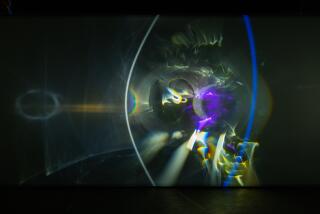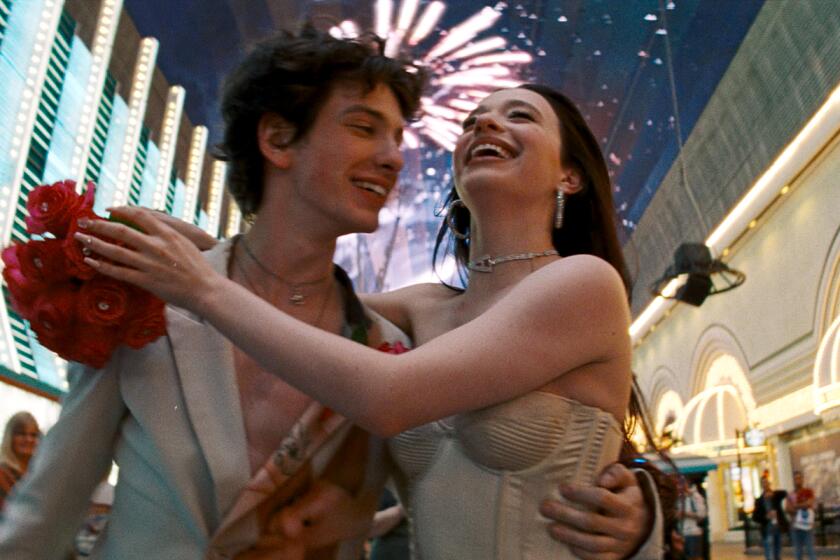Richard Serra’s steely will
- Share via
NEW YORK — They may have to coin a new category of art to describe Richard Serra’s revolutionary creations. His colossal mazes of fabricated steel, with their eerie effects, have taken sculpture into a new realm.
Once ridiculed for his “Tilted Arc” -- a 10-foot-high wall of steel at the Federal Plaza in New York, demolished in 1989 because of the public outcry -- Serra stuck to his artistic vision and gained renown for site-specific monuments that now dot the globe.
He’s acclaimed as “one of the most important, preeminent artists of our era,” said Glenn D. Lowry, director of the Museum of Modern Art, which is opening a landmark Serra retrospective this weekend.
Three of his labyrinthian sculptures in russet-colored steel -- “Band,” “Sequence” and “Torqued Torus Inversion,” all fabricated last year at a foundry in Siegen, Germany -- are being unveiled in a block-wide, 20,000-square-foot gallery at MoMA.
With this long-planned Serra exhibit in mind, the showroom was built with reinforced floors to support works that weigh as much as 200 tons.
Nearly 15-foot-high sections of 2-inch-thick steel had to be mechanically lifted into the second-floor gallery through a door in the museum wall, then carefully reassembled and balanced by veteran riggers.
Two other walk-in works in weathered steel -- “Intersection II” (1992-93) and “Torqued Ellipse IV” (1998), each 50 feet long and 13 feet high -- were lifted by crane into MoMA’s sculpture garden and erected beside a marble reflecting pool, with the Midtown skyline as a backdrop.
The massive structures seem to tilt precariously. “Do not touch,” declare signs, but the warnings explain that “even clean hands” can damage the surfaces. Guards will have to stay alert, because a playful quality in these sculptures seems to invite interaction with the weighty works.
“Richard Serra, Forty Years of Sculpture,” a one-time show running Sunday through Sept. 10, includes 22 other experimental objects in rubber, fiberglass, neon and lead from the 1960s, and his early steel plate art from the 1970s and 1980s. The San Francisco native first joined New York’s downtown art scene in 1966, following art studies at Yale University and in Europe.
The MoMA show was erected under the close supervision of the feisty 67-year-old, who dresses in black and easily converses about the many artistic influences on his career, including painter Diego Velazquez, sculptor Alberto Giacometti and New York writers, musicians and choreographers.
With sharply angled walls and high sweeping curves, Serra’s sculptures induce mind-bending, even disorienting effects. The shapes evoke familiar shapes -- the hull of a ship, cooling towers, curtain-like strips. Yet while strolling through the structures, it’s easy to lose track of where a work starts and ends, underlining that empty spaces and a sense of movement are integral to the works.
“There is a moment when two spirals seem to change direction,” Serra told journalists at a preview, describing one dizzying consequence of the conjoined, 65-foot-long “Sequence.” At both ends, visitors can enter through one of two openings -- one leading to an interior area, the other to a long walk through a space formed by the inner and outer steel walls.
The adjacent “Band” flows horizontally and lacks a definitive interior or exterior. The continuous band curves inward and outward to a length of more than 70 feet, forming four distinct cavities.
In Serra’s explanation, the two works “promote movement through form. In both, form appears indeterminate and unpredictable, with constant variations of the surface throughout.”
Serra, who was a steelworker as a young man in California, acquired the knowledge that allowed him to use the material in ways that came to define his career.
“Artists who had used steel before did not deal with its tectonic potential, its weight, its compression, its mass, its status -- that wasn’t knowledge that was in the art world,” Serra says in the show’s catalog.
“I’d put trusses together as a kid and I’d stuck rivets and I’d seen steel being rigged, so I had no fear of ordering” large plates of steel that weighed 6 or 7 tons, he said, the very segments he shaped into boundary-breaking sculptures.
More to Read
The biggest entertainment stories
Get our big stories about Hollywood, film, television, music, arts, culture and more right in your inbox as soon as they publish.
You may occasionally receive promotional content from the Los Angeles Times.










